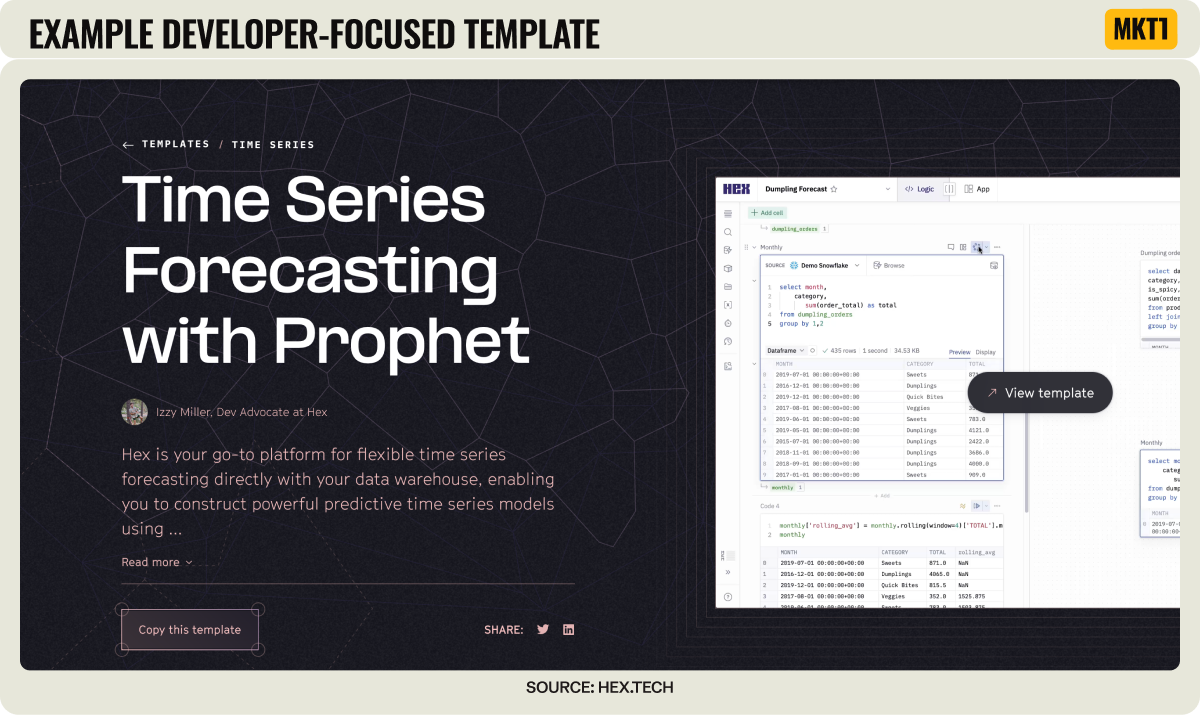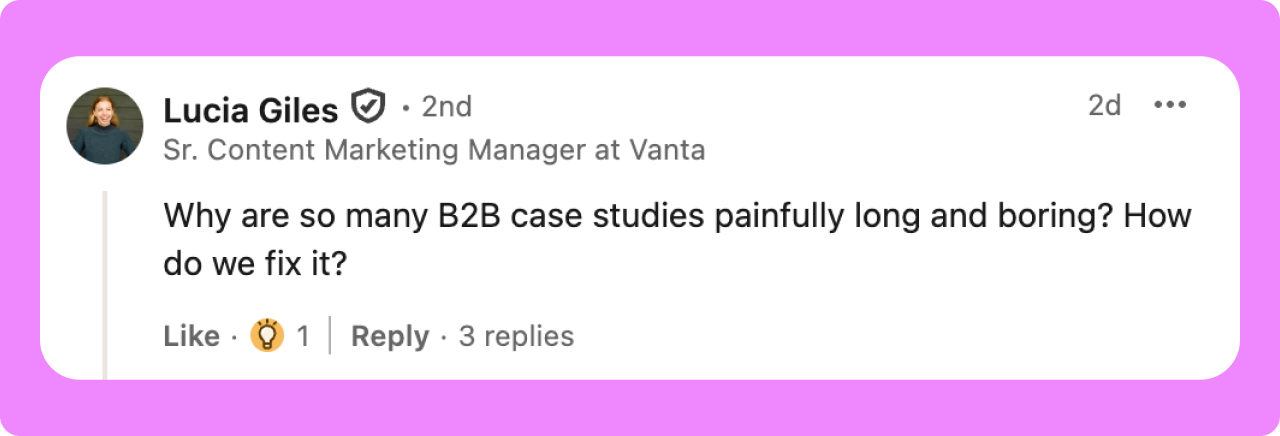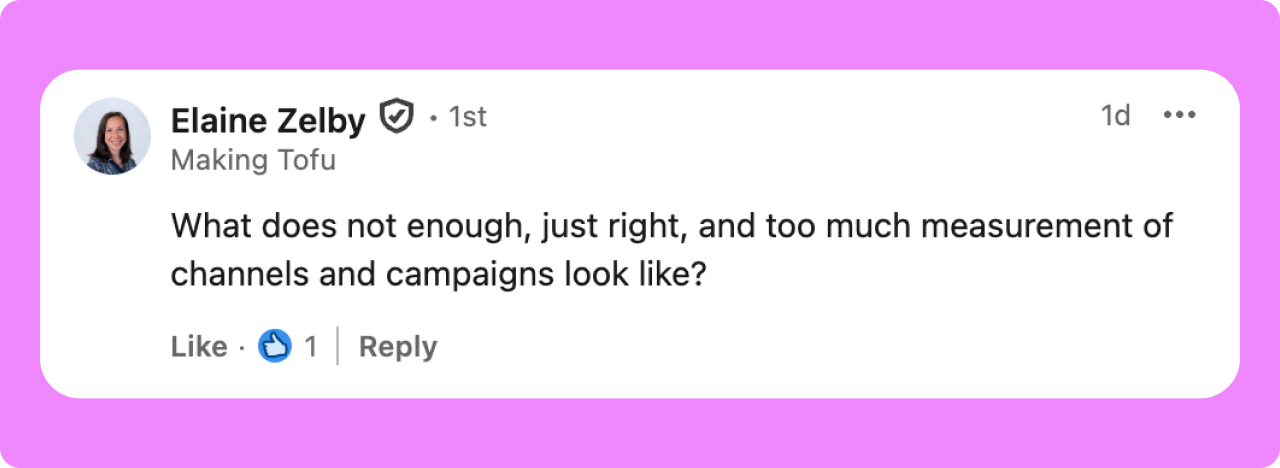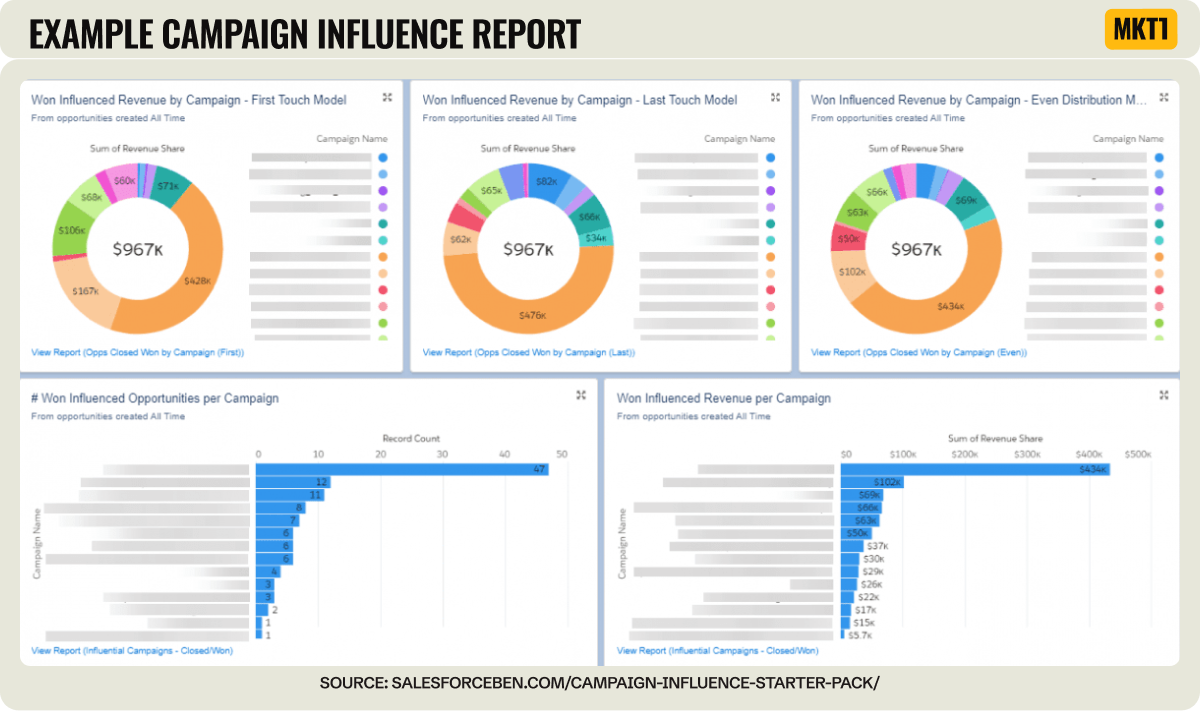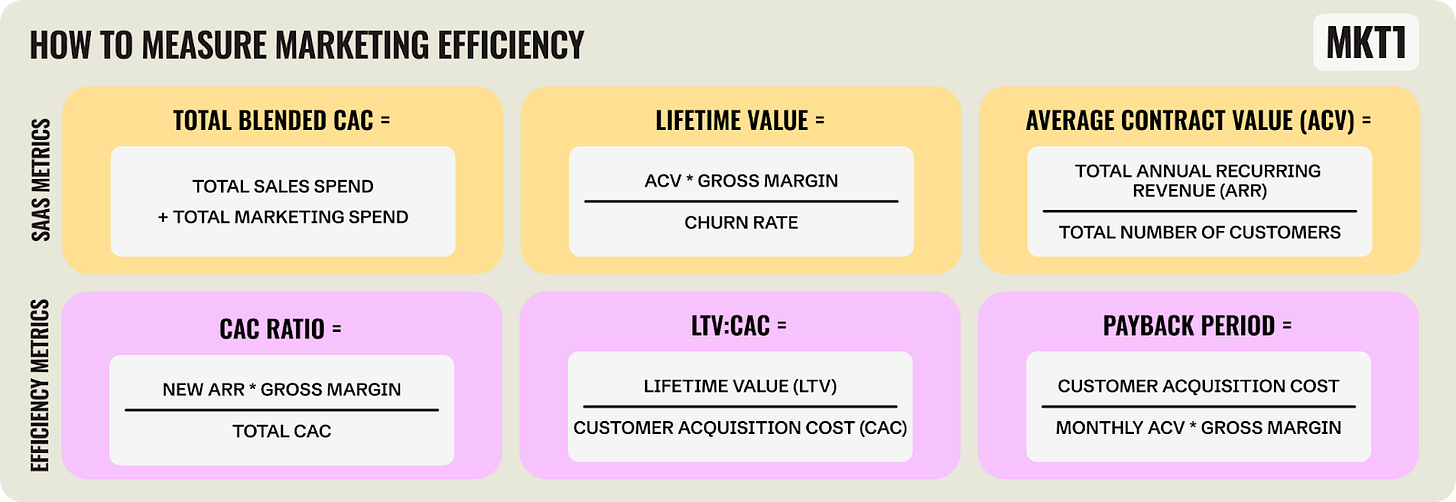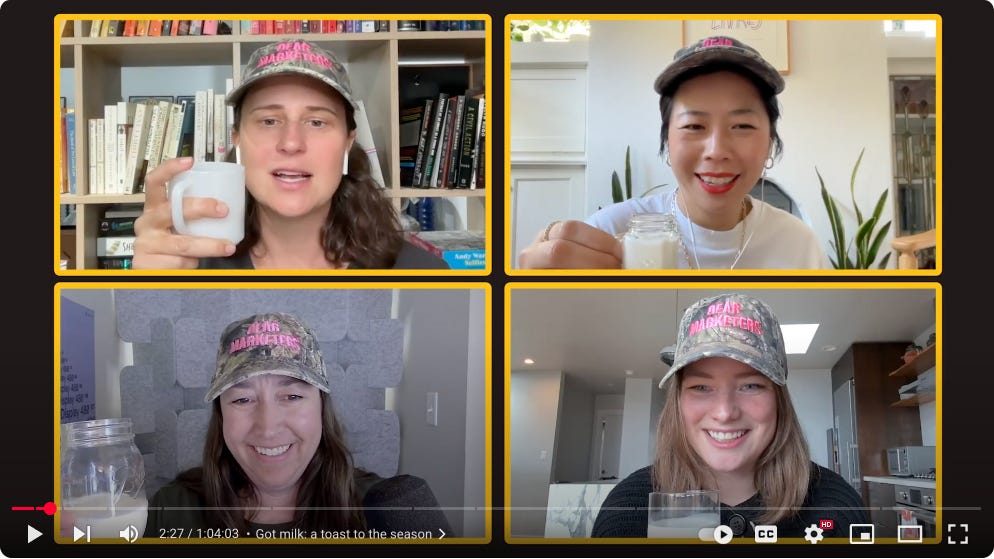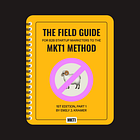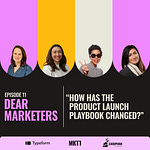🎙️ This free edition of MKT1 newsletter covers Season 1, Episode 12 of “Dear Marketers with Emily Kramer & Friends” podcast, brought to you by Typeform, Framer & 42 Agency.
Listen or watch the podcast on Spotify, Apple Podcasts, or YouTube. Plus read the full newsletter below for an even deeper dive on the topic. The newsletter is meant to augment the podcast, not just recap it.
“Dear Marketers, We have more questions!”
This is the last episode of season 1 of the podcast. This finale is a “mailbag” of questions we didn’t answer in the previous 11 episodes, but we thought deserved a response. If you don’t know what a mailbag is (I didn’t), think of this like an AMA or one big Dear Marketers lightning round. Will there be a season 2? More at the end of this newsletter.
When answering these questions during the episode, there were three questions that really stood out as topics we have hot takes on that demanded a longer response. This newsletter is dedicated to giving those three questions the longer answers they deserve. (I got so fired up about one question during recording, I rage-ripped my Croc apart! Yes, it was a question about attribution)
In this newsletter and podcast:
My co-hosts, Devon Watts (Head of Product Marketing and Partner Marketing at Mercury), Jenny Thai (Head of Content at Vanta), and Grace Erickson (VP of Revenue at Cocoon) cover a smattering of topics, three in depth in the newsletter and ten total in the podcast.
This newsletter is focused on 3 topics:
Podcast Episode 12 covers 10 questions, including:
(We really should have made it 12 questions, but too late now!)
🧸 Which brands are doing B2C marketing well?
🎯 What is a marketing campaign and what isn’t? Does it matter?
🪜 How do you move upmarket?
🏆 How does positioning change when you target multiple verticals?
⬇️ And more. Full list down at the bottom of this newsletter, with time stamps!
Thanks to our Dear Marketers sponsors:
I vet each partner personally and these are genuine recommendations (even though yes, we do get paid for this).
Typeform: Typeform made season 1 of Dear Marketers possible as our presenting partner, thanks! Typeform isn’t just for creating beautiful forms and collecting responses, you can summarize answers with AI, embed video, enrich data, route leads, and connect with 300+ tools.
🎁 Offer: Use code MKT1 to get 20% off their annual growth plan.
__
Framer is a no-code website builder that feels like a design tool. With new AI layout generation, built-in analytics, and vector drawing, it’s even easier to build, test, and launch sites faster. Thanks for being a partner since Episode 4!
🎁 Offer: Framer will rebuild or migrate your site for free in 3 days. New and existing teams on a Scale Plan are eligible: just submit your brief here.
__
42 Agency: Let 42 Agency handle the MOPS work your team avoids. From routing logic and fixing scoring to aligning Hubspot + Salesforce, 42 Agency is ready to help your B2B startup clean up and scale your ops.
🎁 Offer: Mention MKT1 to get 10% off a Hubspot Audit or Hubspot Sprint.
Watch Episode 12 here, or keep reading for the full newsletter:
You can also listen to the podcast on Spotify or Apple Podcasts.
Now, I’ll deep dive into 3 out of 10 questions cover in this episode:
🧑💻 How is marketing to developers different than other B2B marketing?
Thanks Allie for submitting this question via our Typeform!
🔥 Hot take: Developer marketing isn’t special—it’s actually how all B2B marketing should work.
We shouldn’t be asking how to market to developers differently—we should be asking why we’re not marketing to everyone this well.
The situation
People assume developers are so allergic to marketing that choosing organic, community-driven approaches over paid channels entirely is the only way. They assume developers will only respond to content of the absolute highest quality and that any hint of fake hype or fluff will immediately turn them off.
These people are actually right. But they aren’t right because developers are some mythical species that are uniquely difficult to market to.
Developer marketing is not an entirely different discipline from other types of B2B marketing. Every marketer on the team doesn’t need to be a SME (subject matter expert) on developers. And you don’t need to cut marketing altogether and just have Developer Relations.
The truth is, every audience, including developers, presents their own unique challenges when marketing to them. Developers have simply forced marketers to meet higher standards. All marketing should be held to a similar standard.
So when I answer Allie’s question about what we should do differently for developer marketing, I’d rather reframe it: What can we learn from developer marketing that we should apply to all other B2B marketing?
“I think the problem isn’t unique, but [developer-focused] companies have found the solution faster…by an imperative of the audience.” – Grace Erickson in Episode 12
“Nobody likes to feel ‘marketed’ to. They like to feel seen and heard.” – Emily Kramer in Episode 12
The solution
The best way to do marketing for any audience, including developers, is to lead with usefulness, prove value fast, speak the audience’s language, and show up where the audience already spends time. That’s not “special” for developers; it’s just good marketing. And it’s how we should approach any ICP, whether that’s developers or roofers.
Here are some marketing tactics that work great for developer marketing that we can apply to all of B2B Marketing:
Content ≠ blog posts: In developer marketing, marketers focus on quality content across multiple mediums with SME input. Content might be a code sample, well-written developer docs, or a social post written by an engineer. For other audiences, you could make a template, a vibe-coded tool, a calculator, or a social post written by a customer, an influencer, or another SME, etc. More in Episode 8 of the pod »
Let the product speak for itself: Developers expect a self-serve experience or demo environment, not opaque hints at what the product does, and a friction-heavy request demo process. For other ICPs, think about a “try before you buy” option, and at least put a walkthrough (from Arcade or a similar product) and pricing on your website.
Respect expertise. Write and design for people who know their craft, without oversimplifying or patronizing. Marketers can learn this by talking to the right people (while obvious, this step is so often skipped)! Find people on your team with this expertise, review customer transcripts, go to events and really listen, or even marry one of these people (My lovely Dear Marketers co-host married an engineer/founder, I’m pretty sure so she could be great at developer marketing).
“Every company should be looking for marketers who can deeply understand the audience and figure out how to add value in a way that's specific to that audience.” – Emily Kramer in Episode 12
“Anything is complex if you don’t know anything about it…the way more important thing is to get a good marketer who has high aptitude and will quickly learn new things deeply.” – Devon Watts in Episode 12
🗂️ How do you make customer case studies that don’t suck?
Thanks Lucia for the question!
🔥 Hot take: Incremental changes won’t make case studies better, so we should take a different approach to customer marketing.
I’ve personally never read even 25% of a traditional case study while researching a product (have you?!).
The situation
Lucia’s right to ask this question: Most B2B case studies are painfully boring and aren’t worth reading. We can’t seem to shake the traditional format: Problem → solution → how we solved it with [insert your company name].
A single quote from a customer can often cover the same ground as a long-form case study, in a far more compact format.
So why do we keep making these? Well, because this is just how it’s been done. We as marketers often default to check the box, random acts of marketing. And sales plays the same game: They ask for what they know, and what they think they need. This is the path of least resistance. Long-form, and often PDF (gasp) case studies are perhaps the quintessential example of this.
But it’s not just case studies. Customer marketing as a whole lacks creativity. Everyone follows the same playbook: a row of logos on your website, a few customer quotes, and some ready-to-go case studies. We can do better at using customers to show our differentiators!
“Sales asks, ‘I need another case study.’ I don’t fault them, they’re really just asking for social proof; and that’s what they’ve been taught to ask for.” – Emily Kramer in Episode 12
“I fear this is gonna get worse before it gets better because of AI-created content. AI delivers a lot of filler words, which is not my style of good writing. AI bases its writing off of existing long, boring case studies, right?” – Devon Watts in Episode 12
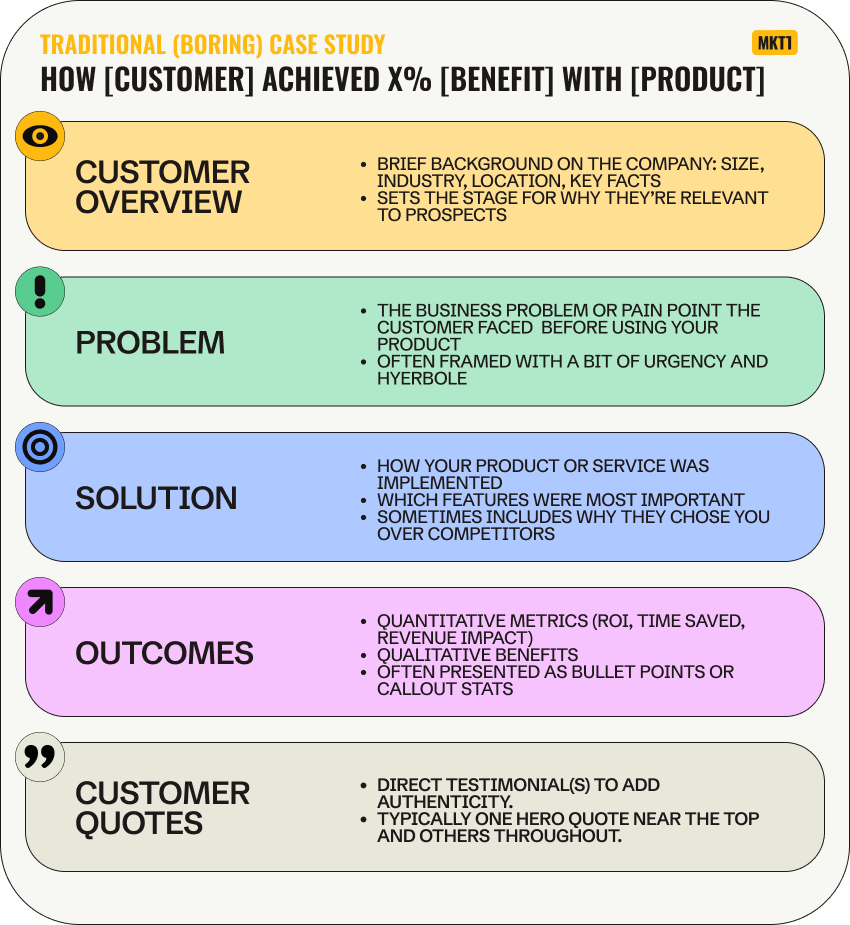
The solution
I don’t think there are incremental improvements that can make a traditional case study that much better. I think the concept needs to be turned on its head. You need to think about how to use customers in compelling ways throughout marketing. You need to get customers talking about you in authentic ways and avoid the long-form, boring writing style that case studies follow. Examples: Typeform’s Get Real Campaign asked for confession style videos from customers and Clay enables creators and agencies (who are also customers) to share how they use the product.
Great customer marketing passes this test: “Would the customer want to share this asset with their own audience?” In other words, is this “fuel” so good that customers want to use their own distribution channels to promote it? They likely would not share a traditional case study. What would they share? That needs to be the bar.
When this customers share, they become an ecosystem marketing channel. They can help you reach new customers. This makes the ROI of that customer content so much higher.
Relatedly, so few companies do customer marketing well that customer love can truly become a marketing advantage: a way you differentiate, stand out, and win on marketing compared to competitors.
“When sales says they need another case study, push back: What’s the real problem here? Are we trying to prove our product works for a certain type of business? Or that we can do a rip-and-replace? Solve for that, not just ‘make another case study.’” – Emily Kramer in Episode 12
“Part of the problem is that we're stuck in the default. Even with all these new tools, we’re like ‘Let's do the same thing, but now we'll do it with AI so it's faster.’ Maybe don't do the same thing at all…rethink the plot. Don't just make the same case studies and PDFs that you've been making.” - Emily Kramer in Episode 12
Here are some simple suggestions to avoid the boring problem:
Problems, not solutions: Have sales make requests using “problem” language, not “solution” language, e.g. “We are having trouble showing that our product can replace [competitor product]”, not “I need a case study about a customer that ripped and replaced [competitor product].” More on managing internal requests in Episode 1 of the pod »
Don’t get tied to the format: Start with the story, not the format. Before deciding if “we need a case study PDF” figure out what’s actually interesting about the customer’s story by talking to them or reviewing transcripts of conversations with them. Then decide the best way(s) to package it—video, short quote, one-pager, interactive page, etc.
Use modern tools to build a customer marketing library. Collect and organize the most compelling parts of customer stories—quotes, stats, and mini-stories—using tools like UserEvidence (automatically gathers content from surveys, reviews, and feedback), Naro (enablement content libraries with usage tracking), or even a vibe-coded internal app built with Lovable or a custom GPT. With a searchable, AI-powered library in place, sales can quickly find what they need and create personalized responses to prospect questions without waiting for a full case study.
For a comprehensive, well-organized list of GTM tools, check out our library here:
Case study, plus: Deliver a shorter-form, yet traditional case study format to satisfy the requests, but use that interview with the customer to get way more interesting stuff.
E.g. ask every customer you interview the same set of (not necessarily product-related) questions in a recorded video. Then you can use that to make a video for each customer, but also a video montage for each question featuring multiple customers.
Involve customers from the start. When creating any type of “fuel,” think about how you can incorporate a customer (or customers) to strengthen it. Not as an afterthought, like a tacked-on quote at the end of a launch announcement, but as a core part of the idea from the beginning.
Amplify when customers do share: When customers actually share something about your product, ask if you can boost it through a thought-leader ad on LinkedIn to give it more reach on your company’s dime. More in LinkedIn post »
“Half the time when sales says they need more case studies, they don’t even know where to find the ones we already have.” – Jenny Thai in Episode 12
“We need to ask better questions. What actually is the meat of the story you’re trying to tell? That’s when it becomes a lot less boring—whether it’s long or not.” – Devon Watts
📈 What is the right amount of measurement?
Thanks Elaine, Co-founder at Tofu!
🔥 Hot take: Campaign influence reporting is the most valuable form of “attribution” reporting.
Campaign influence reporting sidesteps unproductive credit battles and gives you a clearer picture of what’s actually moving the needle.
The situation
In general, when it comes to measurement, Elaine’s right, so few companies get analytics and reporting right. I typically see startups run into 4 main problems with measurement, reporting, and attribution:
Too little measurement and reporting: Reporting is vague, data is missing, and you can’t answer simple questions like: “Which campaigns are influencing pipeline?” and “Are we acquiring customers more efficiently over time?”
Credit > learning: We spend way too long trying to give teams “credit” instead of trying to figure out what works. Attribution is often treated as a scoreboard to prove which team or channel deserves credit, rather than a tool for understanding what’s working and where to invest next.
Over-focusing on channels in isolation: When ROI is evaluated for each channel separately, you’re ignoring the fact that channels work together. Cutting a channel that looks inefficient in isolation can hurt the performance of other channels.
E.g. Events can look expensive and slow to convert if measured alone, but they often spark the relationships and awareness that make follow-up campaigns, outbound sequences, and even inbound content perform. Cut these events and those “efficient” channels may suddenly drop in effectiveness.
Over-reliance on “original” source or “first-touch” attribution: Too many teams still treat “lead source” or the first recorded interaction with an account as the main measure of marketing impact—this is a dated way to do marketing measurement!
In modern account-driven GTM, the “original source” (as Hubspot calls it) or “first touch” is often just list building (e.g., research, enrichment, outbound list import).
If it’s recorded as this, it ignores the later campaigns and touchpoints that move opportunities forward (like inbound, social, etc), undervaluing high-impact work and missing the multi-touch, cross-channel reality of how B2B marketing actually works.
“‘Too much’ is spending all your time trying to instrument attribution and measurement and not actually doing things.” - Emily Kramer in Episode 12
“The point of attribution is to inform your go-to-market model of what’s working, what you should do more of, what you need to address…not credit.” – Grace Erickson in Episode 12
“The ways we used to do basic attribution, by figuring out how people came to you, doesn't work anymore. If you were doing marketing the 2025 way, you're putting all of your accounts into your CRM or database in advance…And if you do that, the first or the original source is gonna be “list” and that is not useful. It's actually much more useful to know what “touch” happened right before a meeting” - Emily Kramer in Episode 12
The solution
You need to focus on understanding the full picture of how you are growing revenue (without starting attribution wars between departments). The best way to do that is to have clear lifecycle stages, layer on Campaign Influence reporting, and understand blended CAC across all GTM activities.
Unfortunately, most of this stuff doesn’t come out of the box in either HubSpot or Salesforce (which is ludicrous, but here we are). But with a little work, you can (and should) get it set up.
1. Set up basic lifecycle (funnel) reporting
In both your marketing automation tool and CRM, define lifecycle stages for both contacts and accounts.
Track: Volume (or dollar value) at each stage, conversion rates between stages, and time between stage changes.
This gives you a shared, data-backed view of how contacts and accounts are moving through the funnel. More on setting up contact and account stages in my account-driven GTM newsletter series »
2. Track the “touch” before a meeting was booked
This is more important than how a lead or account got into your system, and increasingly so since you should be researching and adding your ICP to your CRM in advance (as mentioned above).
Instead, capture the touch before important funnel milestones, specifically a meeting booked or opportunity created (which might be the same thing in your lifecycle stages). This tells you what happened at pivotal moments.
In HubSpot: Use a workflow triggered by “meeting booked” or “deal created” to capture the most recent campaign, source, or interaction before that date, and store it in a custom property for reporting.
In Salesforce: Use Campaign Member records to find the last campaign touch before the meeting or opportunity creation date, and store it or report on it directly.
3. Set up Campaign Influence reporting
Campaign influence reports show which opportunities and revenue were impacted by a campaign, and whether or not that campaign is what “created the opportunity.” Instead of crediting only the first or last touch, it looks at all the campaigns a contact or account engaged with before or during the sales process and marks them as “influenced” by said campaign.
In HubSpot Marketing Hub
Go to Marketing > Campaigns to create a campaign, then tag all related campaign assets (emails, landing pages, blog posts, ads, forms, workflows, CTAs). Note: only available for Professional + plans
HubSpot will automatically roll up engagement, influence contacts, deals, and revenue to that campaign.
To measure business impact, use the Attribution Report (Reports > Analytics Tools) filtered by campaign to view influenced pipeline and revenue.
In Salesforce CRM:
Create a Campaign record for each initiative (using a consistent naming convention) and add everyone who engages as a Campaign Member—either automatically from your marketing automation tool or manually via imports (e.g., event lists, partner leads).
Enable Campaign Influence in Salesforce Setup (the admin area), then use the built-in Campaign Influence reports and dashboards to see which opportunities and revenue were tied to each campaign.
Note: Hubspot and Salesforce approach “campaign influence” with slightly different models, but both make it possible to set up the general concept of campaign influence reporting.
4. Start measuring blended CAC
Move beyond channel-by-channel CAC and track your blended CAC. Blended CAC is the total cost to acquire a customer across all marketing, sales, and partnership spend.
This keeps you focused on how your GTM system works as a whole, rather than trying to make each individual channel look efficient in isolation.
You can also use this to calculate payback period, LTV:CAC, etc. I wrote about this before and it was truthfully quite arduous to write about, so I’ll just send you over to that newsletter for more! More on marketing metrics in this newsletter »
“Marketing is not linear. People come in different ways. What’s important is to know all of the things that are influencing pipeline and revenue, which is typically called Campaign Influence [Reporting].” - Emily Kramer in Episode 12
“The goal should be improve blended CAC and payback periods over time. The question you're trying to answer is not even ‘Was this channel effective or was this campaign effective? But are we acquiring customers in an increasingly more efficient way across marketing, sales, and partnerships—fully blended?’” - Devon Watts in Episode 12
But if you do just two things better…
1. Spend more time getting campaign influence reporting right.
Campaign influence reporting forces you to think about marketing as integrated initiatives, not siloed activities, and keeps the focus on revenue impact, not vanity metrics. It’s the best antidote to the political “credit” fights that come with channel-only attribution—and, when set up well, it’s the single most valuable attribution view you can have.
It measures how coordinated marketing efforts (fuel + engine) actually influence pipeline and revenue, recognizing that campaigns often run across multiple channels and touchpoints, and that a single deal may be influenced by several campaigns over time. For example: An account might first see you at an industry event, then attend a product webinar, then read a customer story before closing. Campaign influence captures all of those touches—not just the first one recorded in your CRM.
In short: It tells you which marketing efforts helped move deals forward, not just who sourced the lead.
2. Stop labeling things as “marketing” or “sales”
When you tag pipeline as “marketing-sourced” or “sales-sourced,” you’re framing it as a turf war instead of a team effort. Same goes for “marketing qualified lead” and “sales qualified lead”—instead, call them qualified 1 or qualified 2 or something similar. In reality, most deals are the result of multiple touches across marketing, sales, and partnerships—and the more you try to force them into one bucket, the more you encourage finger-pointing instead of collaboration. Keep the conversation focused on what’s working to move deals forward.
Additional reading on measurement, reporting, attribution, and KPIs:
Does attribution help or hurt sales and marketing alignment in Episode 6 »
Newsletter deep dive into how to do marketing analytics from last year »
Newsletter on budgeting, forecasting, and marketing efficiency metrics »
And now for my favorite question of the season…
We answered a whole lot of questions this season, but perhaps the most important question came from Julia Wiltshire:
Bridging the gap between founders, investors, other teams, and marketers is the primary reason I started MKT1. I developed most of my “krameworks” with this in mind—making them highly shareable and explaining marketing in a way that’s easy for anyone to digest. We recently detailed the core MKT1 frameworks in our Field Guide (and part 2 is out next week) which is a great starting place to know what to share.
So here’s my self-promotional answer to the question: Listen to Dear Marketers and read MKT1 newsletter, and share what you learn. I can promise you founders love the Fuel & Engine, Marketing Advantages, and Perceptions Frameworks.
More in the podcast…
Here’s the full list of questions we cover in this episode:
[03:13] “What did you most love and what did you least love about doing the podcast?” – Anna Furmanov
[06:08] “Which brands do you think are doing the most interesting/innovative B2C marketing?” – Sayed Bin Habib
[09:44] “What even is a marketing campaign anyway? And what isn’t? And does it matter?” – Sinziana Ursu, Demand Generation and Digital Leader
[17:00] “How should startups think about balancing experimentation with more traditional project planning?” – Stuart Bramfeld
[26:23] “Why are so many B2B case studies painfully long and boring? How do we fix it?” – Lucia Giles
[30:34] “How do you think about the role the marketing team plays when supporting technical products (data and developer tooling companies)?” – Allie Beazell
[36:45] “How does the process or framework for developing positioning change for different verticals or startup stages?” – Briana Ottoboni
[41:06] “Moving up market is a challenge. What are key indicators that your company is successfully moving up market? What are the best marketing strategies to move up market?” – Cori Hamoor
[46:14] “What does not enough, just right, and too much measurement of channels and campaigns look like?” – Elaine Zelby
[51:14] “How do we finally get CEOs to respect us? Is that too much for 10 min?” – Julia Wiltshire
🙏 Thanks
A huge thanks to my dear friends Jenny, Devon, and Grace for making Season 1 so much fun to record (and hopefully fun to listen to). It’s been a privilege having you three carve out time from schedules full of full-time jobs, kids and dogs, Labubu collecting, pontoon boating, milk drinking and for generally being great friends—this will all make more sense if you listen to the episode! Go follow them all on LinkedIn if you haven’t yet.
And of course thanks again to our sponsors: Typeform, Framer & 42 Agency.
And thanks to you for listening and reading this season!
Will there be a season 2?
When I set out to launch a podcast, I chose a season format instead of just starting with no end in sight (note: this is my recommended approach for any B2B startup launching a podcast too).
That said…there’s a high likelihood we’ll be back with Season 2 of Dear Marketers with Emily Kramer & Friends in early 2026. We may even bring in some new friends. If you’re interested in being a presenting sponsor, reach out: sponsorships@mkt1.co.
And go rate us on Apple Podcasts and Spotify if you want to hear a season 2! And subscribe to the YouTube channel—this fall, I’m launching a new video series there to help you discover the best new marketing tools.
More from MKT1 & Dear Marketers
⭐ Please rate us or subscribe wherever you get your podcasts: Spotify, Apple Podcasts, or YouTube. Season 1 is over (Episode 12 is our last), so convince us to do a Season 2.
🐱 Templates & resources for paid subscribers only »
🛠️ Don’t miss our brand-new GTM tools library for discovering new tools, available to all subscribers for a limited time.
📰 Next “deep dive” newsletter: The MKT1 B2B marketing field guide part 2, check out part 1 here:








